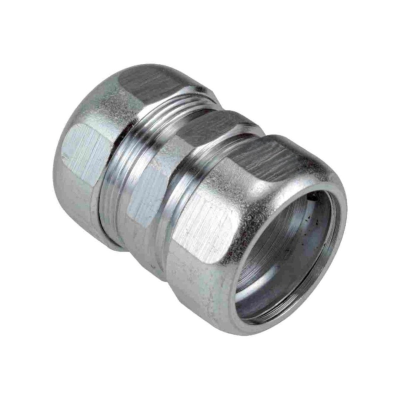Looking for a reliable and durable way to connect your pipes? Compression couplings offer a versatile and easy-to-install solution for various plumbing applications. Learn about the different types of compression couplings, their benefits, and how to choose the right one for your project.
What is Compression Coupling?
A compression coupling is a mechanical fitting used to connect two pipes together. It’s designed to provide a secure and leak-proof seal, making it a popular choice in various plumbing applications.
Compression couplings work by utilizing a compression ring or ferrule that is squeezed tightly against the pipe, creating a seal. This mechanism ensures a reliable connection without the need for soldering or threading.
Key Components:
➡️ Nuts: These are threaded components that are tightened to compress the ferrule and create the seal.
➡️ Ferrules: These are metal rings that fit inside the pipe and against the coupling, providing the sealing surface.
➡️ Fittings: These are the parts that connect the pipes to the coupling, such as elbows, tees, and unions.
Types of Compression Couplings
Compression couplings come in various types, each designed for specific applications.
Standard vs. Transition Couplings:
➡️ Standard couplings: These are used to connect pipes of the same material and diameter.
➡️ Transition couplings: These are used to connect pipes of different materials or diameters.
Applications of Different Types in Plumbing and Beyond:
➡️ Residential: Connecting water supply lines, gas lines, and drainage pipes.
➡️ Commercial: Plumbing systems in buildings, including offices, retail spaces, and hotels.
➡️ Industrial: Piping systems in factories, plants, and refineries.
Benefits of Using Compression Coupling
Compression couplings offer several advantages that make them a popular choice for plumbing and other applications.
Durability and Longevity:
➡️ Compression couplings are known for their long lifespan and resistance to wear and tear.
➡️ The compression mechanism ensures a secure seal that can withstand repeated use.
Strength of Material and Resistance to Rips and Tears:
➡️ Compression couplings are typically made from high-quality materials, such as brass or stainless steel, which provide excellent durability and corrosion resistance.
Performance Under High Pressure and Temperature Conditions:
➡️ Compression couplings are designed to handle high pressure and temperature conditions, making them suitable for demanding applications.
Ease of Installation:
➡️ Compression couplings are relatively easy to install compared to other types of fittings.
➡️ They do not require soldering or threading, which can be time-consuming and require specialized skills.
Step-by-Step Guide to Installing a Compression Coupling:
1. Cut the pipes to the correct length and smooth off any burrs to prepare them.
2. Insert the ferrule into the pipe.
3. Slide the coupling over the pipe and ferrule.
4. Tighten the nut using a wrench or pliers until it is snug, but do not overtighten.
Common Mistakes to Avoid During Installation:
➡️ Overtightening: This can damage the ferrule and compromise the seal.
➡️ Using the wrong size ferrule: The ferrule must be the correct size for the pipe.
➡️ Not removing burrs: Burrs can interfere with the seal and cause leaks.
Versatility in Applications:
➡️ Compression couplings can be used in a wide range of applications, including residential, commercial, and industrial settings.
➡️ They are compatible with various pipe materials, such as copper, PVC, PEX, and more.
Compression Coupling Maintenance and Troubleshooting
Proper maintenance is essential to ensure the longevity and performance of compression couplings.
How to Maintain Your Compression Coupling for Longevity:
➡️ Regular inspection: Inspect the coupling periodically for signs of wear or damage.
➡️ Tightening: If the coupling feels loose, tighten the nut slightly.
Recognizing Signs of Wear and When to Replace:
➡️ Leaks: A leak is a clear sign that the coupling is not sealing properly.
➡️ Corrosion: Corrosion can weaken the coupling and cause it to fail.
Troubleshooting Common Issues:
➡️ Leaks: Leaks can be caused by a loose nut, a damaged ferrule, or a misaligned pipe.
➡️ Improperly installed couplings: If the coupling was not installed correctly, it may need to be reinstalled.
Choosing the Right Compression Coupling for Your Job
When selecting a compression coupling, it is important to consider several factors.
Factors to Consider When Selecting a Compression Coupling:
➡️ Pipe material and size compatibility: Ensure that the coupling is compatible with the pipe material and size.
➡️ Environmental factors: Consider the temperature, pressure, and chemical exposure the coupling will be subjected to.
Conclusion
Compression couplings are a reliable and versatile solution for connecting pipes in various applications. Their durability, ease of installation, and compatibility with different pipe materials make them a popular choice among homeowners, contractors, and industrial professionals.
By following the guidelines for installation, maintenance, and troubleshooting, you can ensure that your compression couplings provide a long-lasting and secure connection.
Post time: Aug-28-2024


